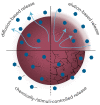Polymeric Nanoparticles for Antimicrobial Therapies: An Up-To-Date Overview
- PMID: 33673451
- PMCID: PMC7956825
- DOI: 10.3390/polym13050724
Polymeric Nanoparticles for Antimicrobial Therapies: An Up-To-Date Overview
Abstract
Despite the many advancements in the pharmaceutical and medical fields and the development of numerous antimicrobial drugs aimed to suppress and destroy pathogenic microorganisms, infectious diseases still represent a major health threat affecting millions of lives daily. In addition to the limitations of antimicrobial drugs associated with low transportation rate, water solubility, oral bioavailability and stability, inefficient drug targeting, considerable toxicity, and limited patient compliance, the major cause for their inefficiency is the antimicrobial resistance of microorganisms. In this context, the risk of a pre-antibiotic era is a real possibility. For this reason, the research focus has shifted toward the discovery and development of novel and alternative antimicrobial agents that could overcome the challenges associated with conventional drugs. Nanotechnology is a possible alternative, as there is significant evidence of the broad-spectrum antimicrobial activity of nanomaterials and nanoparticles in particular. Moreover, owing to their considerable advantages regarding their efficient cargo dissolving, entrapment, encapsulation, or surface attachment, the possibility of forming antimicrobial groups for specific targeting and destruction, biocompatibility and biodegradability, low toxicity, and synergistic therapy, polymeric nanoparticles have received considerable attention as potential antimicrobial drug delivery agents. In this context, the aim of this paper is to provide an up-to-date overview of the most recent studies investigating polymeric nanoparticles designed for antimicrobial therapies, describing both their targeting strategies and their effects.
Keywords: antimicrobial resistance; antimicrobial therapy; limited patient compliance; medical field; nanomaterials; nanotechnology; polymeric nanoparticles; targeting strategies; toxicity; up-to-date overview.
Conflict of interest statement
The authors declare no conflict of interest.
Figures






References
-
- Tripathi L.P., Chen Y.-A., Mizuguchi K., Morita E. Network-Based Analysis of Host-Pathogen Interactions. Encycl. Bioinform. Comput. Biol. 2019;3:932–937.
-
- Roberts C.A., Buikstra J.E. Other’s Identification of Pathological Conditions in Human Skeletal Remains. 3rd ed. Elsevier; Amsterdam, The Netherlands: 2019. Bacterial infections; pp. 321–349.
Publication types
LinkOut - more resources
Full Text Sources
Other Literature Sources
Molecular Biology Databases

